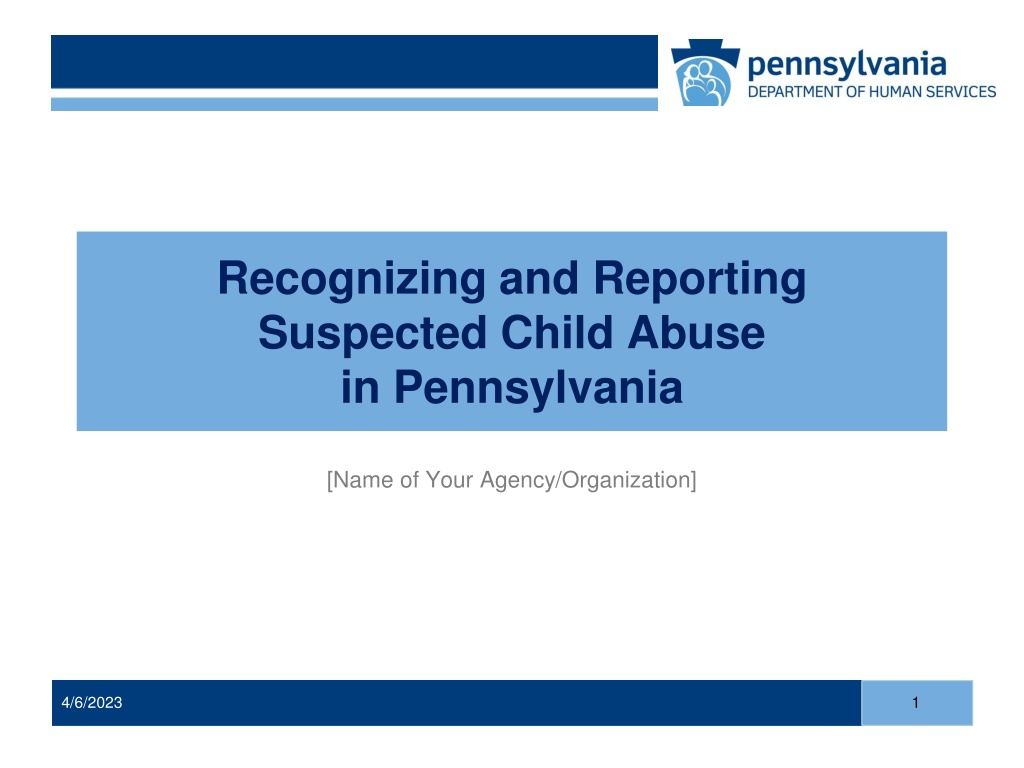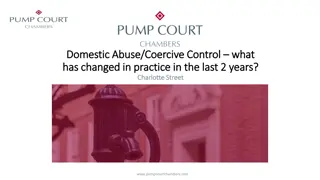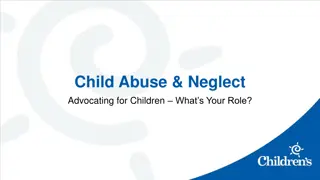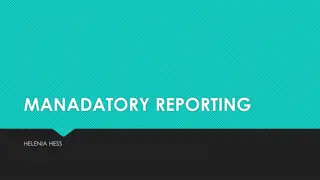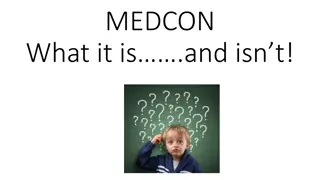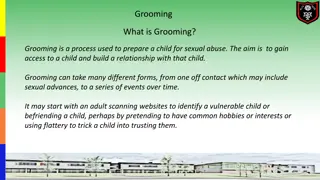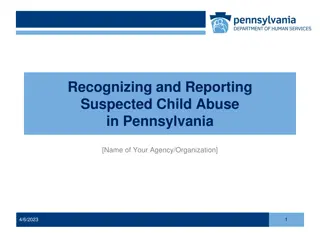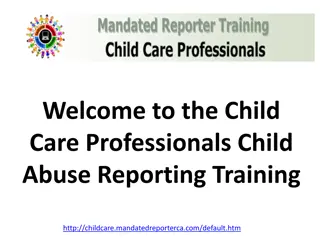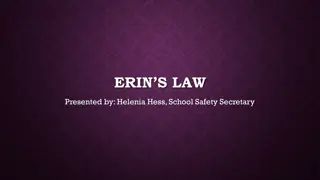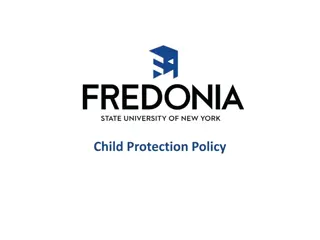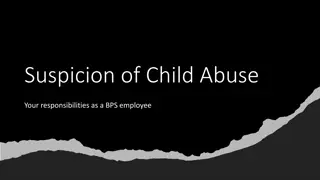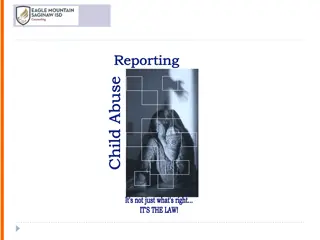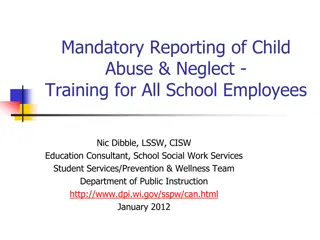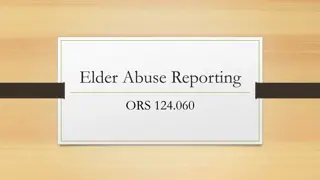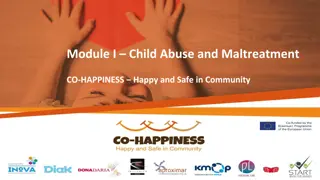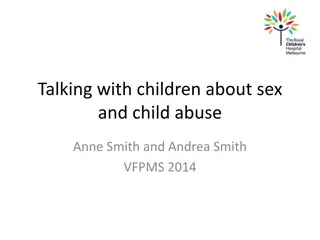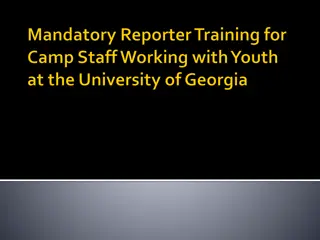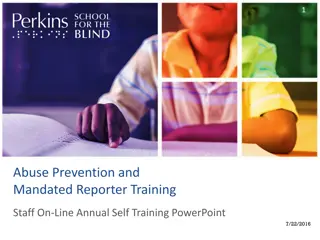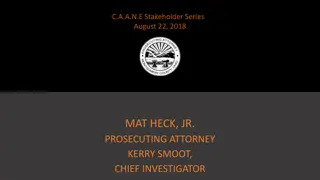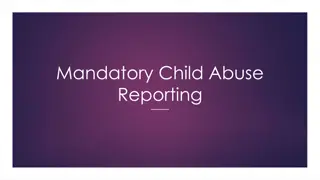Recognizing and Reporting Suspected Child Abuse Training in Pennsylvania
This training provides essential information on recognizing and reporting suspected child abuse in Pennsylvania, covering topics such as child welfare laws, reporting procedures, and penalties for failure to report. Targeted towards mandated reporters, healthcare professionals, and others in relevant fields, this course aims to educate participants on their responsibilities in protecting children from abuse.
Download Presentation

Please find below an Image/Link to download the presentation.
The content on the website is provided AS IS for your information and personal use only. It may not be sold, licensed, or shared on other websites without obtaining consent from the author. Download presentation by click this link. If you encounter any issues during the download, it is possible that the publisher has removed the file from their server.
E N D
Presentation Transcript
Recognizing and Reporting Suspected Child Abuse in Pennsylvania [Name of Your Agency/Organization] 4/6/2023 1
Introduction Suggestion: Introduce the presenter(s). Provide your agency/organization s contact information (e.g., email address, phone number, link to website) in which participants can contact if they have questions related to the course such as navigating the course, obtaining their Certificate of Completion, etc. Introduce your agency/organization. Provide the link to our Trainings page, on our Keep Kids Safe website https://www.dhs.pa.gov/KeepKidsSafe/Pages/Trainings.aspx. 2 3/9/2024
Course Overview 4/6/2023 3
Course Overview Suggestion: Agenda/Outline I. Recognizing and Reporting Suspected Child Abuse in Pennsylvania A. Course Overview B. Child Welfare in Pennsylvania C. Mandatory Notification of Substance Exposed Infants by Health Care Providers & Plan of Safe Care D. Recognizing Suspected Child Abuse E. Reporting Suspected Child Abuse F. Case/Reporting Scenarios G. Quiz Questions H. Sources *see notes section associated with this slide for more guidance* 4 3/9/2024
Course Overview Suggestion: Learning Objectives Should cover the Key Takeaways (*see notes section associated with this slide*) and be worded in a way that reflects what the audience will learn, such as: Definition/categories of child abuse as outlined in the PA CPSL Common indicators of suspected child abuse Roles and responsibilities for persons required to report suspected child abuse (mandated reporters) Requirements and procedures for reporting suspected child abuse Penalties for mandated reporters who willfully fail to report suspected child abuse 5 3/9/2024
Course Overview Suggestion: Targeted/Intended Audience Provide a brief description of the targeted/intended audience, such as: Mandated reporters Mandated reporters Mandated and permissive reporters Individuals seeking or renewing licensure in Pennsylvania School staff, school contractors, school volunteers Healthcare professionals Mental health professionals 6 3/9/2024
Course Overview Suggestion: Approval(s)/Credit Number of credit hours three (3) hours or two (2) hours Indicate training approval(s) and relevant requirements completing your training will fulfill, such as: This training is approved by the Pennsylvania Department of Human Services (DHS) in accordance with 23 Pa.C.S. 6383 (relating to education and training). Note: Those applying for initial licensure/certification under the jurisdiction of DOS must take a 3-hour training approved by DHS. This training is approved by the Pennsylvania Department of State (DOS) in accordance with Act 31 of 2014 for professional licensees. Note: Those renewing licensure/certification under the jurisdiction of DOS must take at least two (2) hours of training jointly approved by DHS and DOS. This training is approved by the Pennsylvania Department of Education (PDE) in accordance with Act 126 of 2012 [(if applicable) for Act 48 CE credit]. Any other relevant requirements completing your training will fulfill 7 3/9/2024
Course Overview Suggestion: Delivery/Navigation Method(s) of delivery, such as: Online In-person Self-study Live How to navigate through the training/presentation, especially if it is online. 8 3/9/2024
Course Overview Suggestion: Materials Any and all materials associated with the curriculum, such as: PowerPoint presentation Hyperlinks Videos Handouts, such as: Glossary for supplementary definitions Pre-test questions Case scenario questions Post-test questions 9 3/9/2024
Course Overview Suggestion: Disclaimers Discuss any additional information or disclaimers you feel are pertinent prior to starting the training, such as: If a participant would want a copy of their Certificate of Completion. They need to contact your agency/organization directly, as your agency/organization is required to maintain all participant records. Note: If your agency/organization is seeking DOS approval: In accordance with DOS standards, your agency/organization is required to electronically forward a participant s information to DOS for the participant to receive credit toward licensure or certification. Participants should contact their licensing board directly to confirm receipt. If a participant s licensing board did not receive confirmation they completed the course, the participant may need to forward their information and their Certificate of Completion to their licensing board directly. 10 3/9/2024
Child Welfare in Pennsylvania 4/6/2023 11
Child Welfare in Pennsylvania Suggestion: Brief history of child welfare in Pennsylvania Data/statistics specific to Pennsylvania *Please provide the source(s)/appropriate citation(s)* 12 3/9/2024
Child Welfare in Pennsylvania The Pennsylvania Child Protective Services Law (CPSL) The Pennsylvania Child Protective Services Law (CPSL) (23 Pa.C.S. Chapter 63, Child Protective Services) was established in 1975 to protect children from abuse, allow the opportunity for healthy growth and development, and preserve and stabilize the family whenever possible. The PA CPSL does not restrict the generally recognized existing rights of parents to use reasonable supervision and control when raising their children. Recent amendments relevant to child abuse recognition and reporting: Act 115 of 2016 (relating to human trafficking) Act 54 of 2018 (relating to notification of substance-exposed infants by healthcare providers & plan of safe care) Act 88 of 2019 (relating to penalties for failure to report or refer) 13 3/9/2024
Child Welfare in Pennsylvania The Pennsylvania Child Welfare System The Pennsylvania child welfare system is state-supervised and county- administered. County children-and-youth agencies (CCYAs) have two main functions: 1. Child Protective Services (CPS) services and activities provided by DHS and each county agency for child abuse cases 2. General Protective Services (GPS) services and activities provided by each county agency for cases requiring protective services as defined by DHS in regulations 14 3/9/2024
Child Welfare in Pennsylvania The Pennsylvania Child Welfare System (cont.) County children-and-youth agencies (CCYAs) have two main functions: 1. Child Protective Services (CPS) services and activities provided by DHS and each county agency for child abuse cases (cont.) Cases identified as CPS require an investigation because the alleged act or failure to act meets the definition of child abuse. The PA CPSL recognizes 10 separate categories of child abuse. Examples of CPS Cases -- Causing bodily injury to a child through any recent act or failure to act Causing sexual abuse or exploitation of a child through any act or failure to act Creating a reasonable likelihood of bodily injury to a child through any recent act or failure to act Creating a likelihood of sexual abuse or exploitation of a child through any recent act or failure to act 15 3/9/2024
Child Welfare in Pennsylvania The Pennsylvania Child Welfare System (cont.) County children-and-youth agencies (CCYAs) have two main functions: 1. Child Protective Services (CPS) services and activities provided by DHS and each county agency for child abuse cases Examples of CPS Cases -- (cont.) Fabricating, feigning or intentionally exaggerating or inducing a medical symptom or disease which results in a potentially harmful medical evaluation or treatment to the child through any recent act Causing or substantially contributing to serious mental injury to a child through any act or failure to act or a series of such acts or failures to act Causing serious physical neglect of a child Engaging in a specific recent per se act Causing the death of the child through any act or failure to act Engaging a child in a severe form of trafficking in persons or sex trafficking 16 3/9/2024
Child Welfare in Pennsylvania The Pennsylvania Child Welfare System (cont.) County children-and-youth agencies (CCYAs) have two main functions: 2. General Protective Services (GPS) services and activities provided by each county agency for cases requiring protective services Cases identified as GPS require an assessment for services and supports. In these cases, the alleged act or failure to act may not meet the definition of child abuse but is still detrimental to a child. The primary purpose of GPS is to protect the rights and welfare of children so that they have an opportunity for healthy growth and development. 17 3/9/2024
Child Welfare in Pennsylvania The Pennsylvania Child Welfare System (cont.) County children-and-youth agencies (CCYAs) have two main functions: 2. General Protective Services (GPS) services and activities provided by each county agency for cases requiring protective services Examples of GPS Cases -- Services to prevent the potential for harm to a child who meets one of the following conditions: (cont.) Is without parental care or control, subsistence, education as required by law, or other care or control necessary for their physical, mental, or emotional health or morals Has been placed for care or adoption in violation of law Has been abandoned by their parents, guardian, or other custodian Is without a parent, guardian, or legal custodian Is habitually and without justification truant from school while subject to compulsory school attendance Is under 10 years of age and has committed a delinquent act 18 3/9/2024
Child Welfare in Pennsylvania The Pennsylvania Child Welfare System (cont.) County children-and-youth agencies (CCYAs) have two main functions: 2. General Protective Services (GPS) services and activities provided by each county agency for cases requiring protective services Examples of GPS Cases -- Services to prevent the potential for harm to a child who meets one of the following conditions: (cont.) Has committed a specific act of habitual disobedience of the reasonable and lawful commands of their parent, guardian, or other custodian and who is ungovernable and found to be in need of care, treatment, or supervision Has been formerly adjudicated dependent under section 6341 of the Juvenile Act (relating to adjudication) and is under the jurisdiction of the court, subject to its conditions or placements, and who commits an act which is ungovernable Has been referred under section 6323 of the Juvenile Act (relating to informal adjustment) and who commits an act which is ungovernable 19 3/9/2024
Mandatory Notification of Substance Exposed Infants by Health Care Providers & Plan of Safe Care (Act 54 of 2018) 4/6/2023 20
Act 54 of 2018 Mandatory Notification of Substance Exposed Infants by Health Care Providers A health care provider shall immediately give notice or cause notice to be given to DHS if the provider is involved in the delivery or care of a child under one year of age and the health care provider has determined, based on standards of professional practice, the child was born affected by: substance use or withdrawal symptoms resulting from prenatal drug exposure; or a Fetal Alcohol Spectrum Disorder. Notification to DHS can be made to ChildLine, electronically through the Child Welfare Portal or by calling 1-800-932-0313. This notification is for the purpose of assessing a child and the child's family for a Plan of Safe Care and shall not constitute a child abuse report. 21 3/9/2024
Act 54 of 2018 Mandatory Notification of Substance Exposed Infants by Health Care Providers (cont.) Health care provider a licensed hospital or health care facility or person who is licensed, certified, or otherwise regulated to provide health care services under the laws of this Commonwealth, including a: physician podiatrist optometrist psychologist physical therapist certified nurse practitioner registered nurse nurse midwife physician s assistant chiropractor dentist pharmacist; or an individual accredited or certified to provide behavioral health services 22 3/9/2024
Act 54 of 2018 Plan of Safe Care (cont.) After notification of a child born affected by substance use or withdrawal symptoms resulting from prenatal drug exposure or a fetal alcohol spectrum disorder: A multidisciplinary team meeting must be held prior to the child's discharge from the health care facility. The meeting will inform an assessment of the needs of the child and the child s parents and immediate caregivers to determine the most appropriate lead agency for developing, implementing, and monitoring a Plan of Safe Care. The child's parents and immediate caregivers must be engaged to identify the need for access to treatment for any substance use disorder or other physical or behavioral health condition that may impact the safety, early childhood development, and well-being of the child. Depending upon the needs of the child and parent(s)/caregiver(s), ongoing involvement of the county agency may not be required. 23 3/9/2024
Act 54 of 2018 Plan of Safe Care (cont.) Multidisciplinary Team for the purpose of informing the Plan of Safe Care, may include: Public health agencies; Maternal and child health agencies; Home visitation programs; Substance use disorder prevention and treatment providers; Mental health providers; Public and private children and youth agencies: Early intervention and developmental services; Courts; Local education agencies Managed care organizations and private insurers; and Hospitals and medical providers. 24 3/9/2024
Recognizing Child Abuse 4/6/2023 25
Recognizing Child Abuse Key Components of Child Abuse Child: An individual under 18 years of age Recent act; Act or failure to act; Recent act or failure to act; Series of Acts or Failures to act Act: Something that is done to harm or cause potential harm to a child Failure to act: Something that is NOT done to prevent harm or potential harm to a child Recent act: Any act committed within two years of the date of the report to DHS or county agency Recent act or failure to act: Any act or failure to act committed within two (2) years of the date of the report to DHS or county agency Intentionally, Knowingly, or Recklessly Intentionally: Done with the direct purpose of causing the type of harm that resulted Knowingly: Awareness that harm is practically certain to result Recklessly: Conscious disregard of substantial and unjustifiable risk 26 3/9/2024
Recognizing Child Abuse Perpetrator An individual who has committed child abuse as defined under section 6303(b.1) of the PA CPSL. NOTE: Nothing under the PA CPSL requires a person who has reasonable cause to suspect a child is a victim of child abuse to identify the person responsible for the child abuse in order to make a report of suspected child abuse. 27 3/9/2024
Recognizing Child Abuse Perpetrator (cont.) The term includes only the following: A parent of the child A spouse or former spouse of the child s parent A paramour or former paramour of the child s parent An individual 14 years of age or older who is responsible for the child s welfare or has direct contact with children as an employee of childcare services, a school, or through a program, activity, or service An individual 14 years of age or older who resides in the same home as the child An individual 18 years of age or older who does not reside in the same home as the child but is related within the third degree of consanguinity or affinity by birth or adoption to the child An individual 18 years of age or older who engages a child in severe forms of trafficking in persons or sex trafficking 28 3/9/2024
Recognizing Child Abuse Perpetrator (cont.) Only the following may be considered a perpetrator for failing to act: A parent of the child A spouse or former spouse of the child s parent A paramour or former paramour of the child s parent An individual 18 years of age or older who is responsible for the child's welfare An individual 18 years of age or older who resides in the same home as the child 29 3/9/2024
Recognizing Child Abuse Categories & Indicators of Child Abuse Child abuse: Intentionally, knowingly, or recklessly doing any of the following: 1) Causing bodily injury to a child through any recent act or failure to act 2) Fabricating, feigning, or intentionally exaggerating or inducing a medical symptom or disease which results in a potentially harmful medical evaluation or treatment to the child through any recent act 3) Causing or substantially contributing to serious mental injury to a child through any act or failure to act or a series of such acts or failures to act 4) Causing sexual abuse or exploitation of a child through any act or failure to act 5) Creating a reasonable likelihood of bodily injury to a child through any recent act or failure to act 6) Creating a likelihood of sexual abuse or exploitation of a child through any recent act or failure to act 7) Causing serious physical neglect of a child 8) Causing the death of the child through any act or failure to act 30 3/9/2024
Recognizing Child Abuse Categories & Indicators of Child Abuse (cont.) Child abuse: Intentionally, knowingly, or recklessly doing any of the following: 9) Engaging a child in a severe form of trafficking in persons or sex trafficking, as those terms are defined under section 103 of the Trafficking Victims Protection Act of 2000 10)Engaging in any of the following recent per se acts: i. Kicking, biting, throwing, burning, stabbing, or cutting a child in a manner that endangers the child ii. Unreasonably restraining or confining a child based on consideration of the method, location, or the duration of the restraint or confinement iii. Forcefully shaking a child under one year of age iv. Forcefully slapping or otherwise striking a child under one year of age v. Interfering with the breathing of a child vi. Causing a child to be present at a location while a violation of 18 Pa.C.S. 7508.2 (relating to operation of methamphetamine laboratory) is occurring, provided the violation is being investigated by law enforcement 31 3/9/2024
Recognizing Child Abuse Categories & Indicators of Child Abuse (cont.) Child abuse: Intentionally, knowingly, or recklessly doing any of the following: 10)Engaging in any of the following recent per se acts (cont.): vii. Leaving a child unsupervised with an individual, other than the child's parent, who the actor knows or reasonably should have known: A. Is required to register as a Tier II or Tier III sexual offender under 42 Pa.C.S. Ch. 97 Subch. H (relating to registration of sexual offenders), where the victim of the sexual offense was under 18 years of age when the crime was committed B. Has been determined to be a sexually violent predator under 42 Pa.C.S. 9799.24 (relating to assessments) or any of its predecessors C. Has been determined to be a sexually violent delinquent child as defined in 42 Pa.C.S. 9799.12 (relating to definitions) D. Has been determined to be a sexually violent predator under 42 Pa.C.S. 9799.58 (relating to assessments) or has to register for life under 42 Pa.C.S. 9799.55(b) (relating to registration) 32 3/9/2024
Recognizing Child Abuse Categories & Indicators of Child Abuse (cont.) Bodily injury: Impairment of physical condition or substantial pain Impairment: If, due to the injury, the child s ability to function is reduced temporarily or permanently in any way Substantial pain: If the child experiences what a reasonable person believes to be substantial pain 33 3/9/2024
Recognizing Child Abuse Categories & Indicators of Child Abuse (cont.) Bodily injury (cont.) Indicators: Fear of going home Fear of parent or caregiver Extreme apprehensiveness/vigilance Pronounced aggression or passivity Flinches easily or avoids being touched Play includes abusive talk or behavior Unexplained injuries Unbelievable or inconsistent explanations of injuries Injuries inconsistent with a child s age/developmental level Unable to recall how injuries occurred or account of injuries is inconsistent with the nature of the injuries Multiple bruises in various stages of healing Bruises located on face, ears, neck, buttocks, back, chest, thighs, back of legs, and genitalia Bruises that resemble objects such as a hand, fist, belt buckle, or rope Burns 34 3/9/2024
Recognizing Child Abuse Categories & Indicators of Child Abuse (cont.) Bodily injury (cont.) Suggestion: At-Risk Youth Populations: *please provide a source/citation* 35 3/9/2024
Recognizing Child Abuse Categories & Indicators of Child Abuse (cont.) Serious mental injury: A psychological condition, as diagnosed by a physician or licensed psychologist, including the refusal of appropriate treatment, that: Renders a child chronically and severely anxious, agitated, depressed, socially withdrawn, psychotic, or in reasonable fear that the child's life or safety is threatened; or Seriously interferes with a child's ability to accomplish age-appropriate developmental and social tasks. 36 3/9/2024
Recognizing Child Abuse Categories & Indicators of Child Abuse (cont.) Serious mental injury (cont.) Indicators: Expressing feelings of inadequacy Fearful of trying new things Overly compliant Poor peer relationships Excessive dependence on adults Habit disorders (sucking, rocking, etc.) Eating disorders Frequent psychosomatic complaints (nausea, stomachache, headache, etc.) Bed-wetting Self-harm Speech disorders 37 3/9/2024
Recognizing Child Abuse Categories & Indicators of Child Abuse (cont.) Serious mental injury (cont.) Suggestion: At-Risk Youth Populations: *please provide a source/citation* 38 3/9/2024
Recognizing Child Abuse Categories & Indicators of Child Abuse (cont.) Serious physical neglect: Any of the following when committed by a perpetrator that endangers a child's life or health, threatens a child's well- being, causes bodily injury, or impairs a child's health, development, or functioning: A repeated, prolonged or egregious failure to supervise a child in a manner that is appropriate considering the child's developmental age and abilities The failure to provide a child with adequate essentials of life, including food, shelter, or medical care 39 3/9/2024
Recognizing Child Abuse Categories & Indicators of Child Abuse (cont.) Serious physical neglect (cont.) Indicators: Not registered in school Inadequate or inappropriate supervision Poor impulse control Frequently fatigued Parentified behaviors Lack of adequate medical and dental care Often hungry Lack of shelter Weight is significantly lower than normal for age and gender Developmental delays Persistent (untreated) conditions (e.g., head lice, diaper rash) Exposure to hazards (e.g., illegal drugs, rodent/insect infestation, mold) Clothing that is dirty, inappropriate for the weather, too small, or too large 40 3/9/2024
Recognizing Child Abuse Categories & Indicators of Child Abuse (cont.) Serious physical neglect (cont.) Suggestion: At-Risk Youth Populations: *please provide a source/citation* 41 3/9/2024
Recognizing Child Abuse Categories & Indicators of Child Abuse (cont.) Sexual abuse or exploitation: The employment, use, persuasion, inducement, enticement, or coercion of a child to engage in or assist another individual to engage in sexually explicit conduct, which includes, but is not limited to, the following: Looking at the sexual or other intimate parts of a child or another individual for the purpose of arousing or gratifying sexual desire in any individual Participating in sexually explicit conversation either in person, by telephone, by computer, or by a computer-aided device for the purpose of sexual stimulation or gratification of any individual Actual or simulated sexual activity or nudity for the purpose of sexual stimulation or gratification of any individual Actual or simulated sexual activity for the purpose of producing visual depiction, including photographing, videotaping, computer depicting, or filming 42 3/9/2024
Recognizing Child Abuse Categories & Indicators of Child Abuse (cont.) Sexual abuse or exploitation: The employment, use, persuasion, inducement, enticement, or coercion of a child to engage in or assist another individual to engage in sexually explicit conduct, which includes, but is not limited to, the following: (cont.) This does not include consensual activities between a child who is 14 years of age or older and another person who is 14 years of age or older and whose age is within four years of the child's age. 43 3/9/2024
Recognizing Child Abuse Categories & Indicators of Child Abuse (cont.) Sexual abuse or exploitation (cont.): Any of the following when committed against a child: Rape as defined in 18 Pa.C.S. 3121 Statutory sexual assault as defined in 18 Pa.C.S. 3122.1 Involuntary deviate sexual intercourse as defined in 18 Pa.C.S. 3123 Sexual assault as defined in 18 Pa.C.S. 3124.1 Institutional sexual assault as defined in 18 Pa.C.S. 3124.2 Aggravated indecent assault as defined in 18 Pa.C.S. 3125 Indecent assault as defined in 18 Pa.C.S. 3126 Indecent exposure as defined in 18 Pa.C.S. 3127 Incest as defined in 18 Pa.C.S. 4302 Prostitution as defined in 18 Pa.C.S. 5902 44 3/9/2024
Recognizing Child Abuse Categories & Indicators of Child Abuse (cont.) Sexual abuse or exploitation (cont.) Indicators: Sexually promiscuous Cruelty to others Cruelty to animals Fire setting Anxious Withdrawn Sleep disturbances Bedwetting Pain or irritation in genital/anal area Difficulty walking or sitting Difficultly urinating Excessive or injurious masturbation Pregnancy Positive testing for sexually- transmitted disease(s) (e.g., HIV) Developmental age-inappropriate sexual play and/or drawings 45 3/9/2024
Recognizing Child Abuse Categories & Indicators of Child Abuse (cont.) Sexual abuse or exploitation (cont.) Suggestion: At-Risk Youth Populations: *please provide a source/citation* 46 3/9/2024
Recognizing Child Abuse Categories & Indicators of Child Abuse (cont.) Severe forms of trafficking in persons (Act 115 of 2016) Sex trafficking in which a commercial sex act is induced by force, fraud, or coercion or in which the person induced to perform such act has not attained 18 years of age; or Sex trafficking: the recruitment, harboring, transportation, provision, or obtaining of a person for the purpose of a commercial sex act Commercial sex act: Any sex act on account of which anything of value is given to or received by any person 47 3/9/2024
Recognizing Child Abuse Categories & Indicators of Child Abuse (cont.) Severe forms of trafficking in persons (Act 115 of 2016) (cont.) The recruitment, harboring, transportation, provision, or obtaining of a person for labor of services, through the use of force, fraud, or coercion, for the purpose of subjection to involuntary servitude, peonage, debt bondage, or slavery. Peonage: paying off debt through work Debt Bondage: debt slavery, bonded labor, or services for a debt or other obligation Slavery: A condition compared to that of a slave in respect of exhausting labor or restricted freedom 48 3/9/2024
Recognizing Child Abuse Categories & Indicators of Child Abuse (cont.) Severe forms of trafficking in persons (Act 115 of 2016) (cont.) Labor trafficking: Labor obtained by use of threat of serious harm, physical restraint, or abuse of legal process Examples: Being forced to work for little or no pay (frequently in factories and farms) Domestic servitude: providing services within a household for 10-16 hours per day, such as, but not limited to: childcare, cooking, cleaning, yard work, gardening, etc. 49 3/9/2024
Recognizing Child Abuse Categories & Indicators of Child Abuse (cont.) Severe forms of trafficking in persons (Act 115 of 2016) (cont.) Victim Identification/Warning Signs including, but not limited to: Has been verified to be under the age of 18 and is in any way involved in a commercial sex act industry or has a record of prior arrest for prostitution or related charges Has an explicitly sexual online profile Excessively frequents internet chat rooms and classified sites Depicts elements of sexual exploitation in drawing, poetry, or other modes of creative expression Is found in a hotel, street track, truck stop, or strip club Has no identification or knowledge of personal data, such as but not limited to: age, name, and/or date of birth Lies about or is not aware of their true age or identity Does not have insurance or control over own finances 50 3/9/2024
